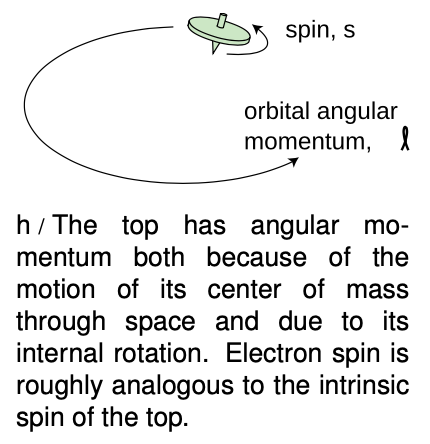LM 36.5 Electron spin Collection
Tags | |
UUID | 1f2558af-f145-11e9-8682-bc764e2038f2 |
36.5 Electron spin by Benjamin Crowell, Light and Matter licensed under the Creative Commons Attribution-ShareAlike license.
36.5 Electron spin
It's disconcerting to the novice ping-pong player to encounter for the first time a more skilled player who can put spin on the ball. Even though you can't see that the ball is spinning, you can tell something is going on by the way it interacts with other objects in its environment. In the same way, we can tell from the way electrons interact with other things that they have an intrinsic spin of their own. Experiments show that even when an electron is not moving through space, it still has angular momentum amounting to ℏ/2.
 This may seem paradoxical because the quantum moat, for instance, gave only angular momenta that were integer multiples of ℏ, not half-units, and I claimed that angular momentum was always quantized in units of ℏ, not just in the case of the quantum moat. That whole discussion, however, assumed that the angular momentum would come from the motion of a particle through space. The ℏ/2 angular momentum of the electron is simply a property of the particle, like its charge or its mass. It has nothing to do with whether the electron is moving or not, and it does not come from any internal motion within the electron. Nobody has ever succeeded in finding any internal structure inside the electron, and even if there was internal structure, it would be mathematically impossible for it to result in a half-unit of angular momentum.
This may seem paradoxical because the quantum moat, for instance, gave only angular momenta that were integer multiples of ℏ, not half-units, and I claimed that angular momentum was always quantized in units of ℏ, not just in the case of the quantum moat. That whole discussion, however, assumed that the angular momentum would come from the motion of a particle through space. The ℏ/2 angular momentum of the electron is simply a property of the particle, like its charge or its mass. It has nothing to do with whether the electron is moving or not, and it does not come from any internal motion within the electron. Nobody has ever succeeded in finding any internal structure inside the electron, and even if there was internal structure, it would be mathematically impossible for it to result in a half-unit of angular momentum.
We simply have to accept this ℏ/2 angular momentum, called the “spin” of the electron - Mother Nature rubs our noses in it as an observed fact. Protons and neutrons have the same ℏ/2 spin, while photons have an intrinsic spin of ℏ. In general, half-integer spins are typical of material particles. Integral values are found for the particles that carry forces: photons, which embody the electric and magnetic fields of force, as well as the more exotic messengers of the nuclear and gravitational forces.
As was the case with ordinary angular momentum, we can describe spin angular momentum in terms of its magnitude, and its component along a given axis. We notate these quantities, in units of ℏ, as s and sz, so an electron has s=1/2 and sz=+1/2 or -1/2.
Taking electron spin into account, we need a total of four quantum numbers to label a state of an electron in the hydrogen atom: n, ℓ, ℓz, and sz. (We omit s because it always has the same value.) The symbols ℓ and ℓzinclude only the angular momentum the electron has because it is moving through space, not its spin angular momentum. The availability of two possible spin states of the electron leads to a doubling of the numbers of states:
| n = 1, | ℓ=0, | ℓz=0, | sz = +1/2 or -1/2 | two states |
| n = 2, | ℓ=0, | ℓz=0, | sz = +1/2 or -1/2 | two states |
| n = 2, | ℓ=01, | ℓz=-1, 0, or 1, | sz = +1/2 or -1/2 | six states |
| … | … |
36.5 Electron spin by Benjamin Crowell, Light and Matter licensed under the Creative Commons Attribution-ShareAlike license.
Calculators and Collections
- Comments
- Attachments
- Stats
No comments |
